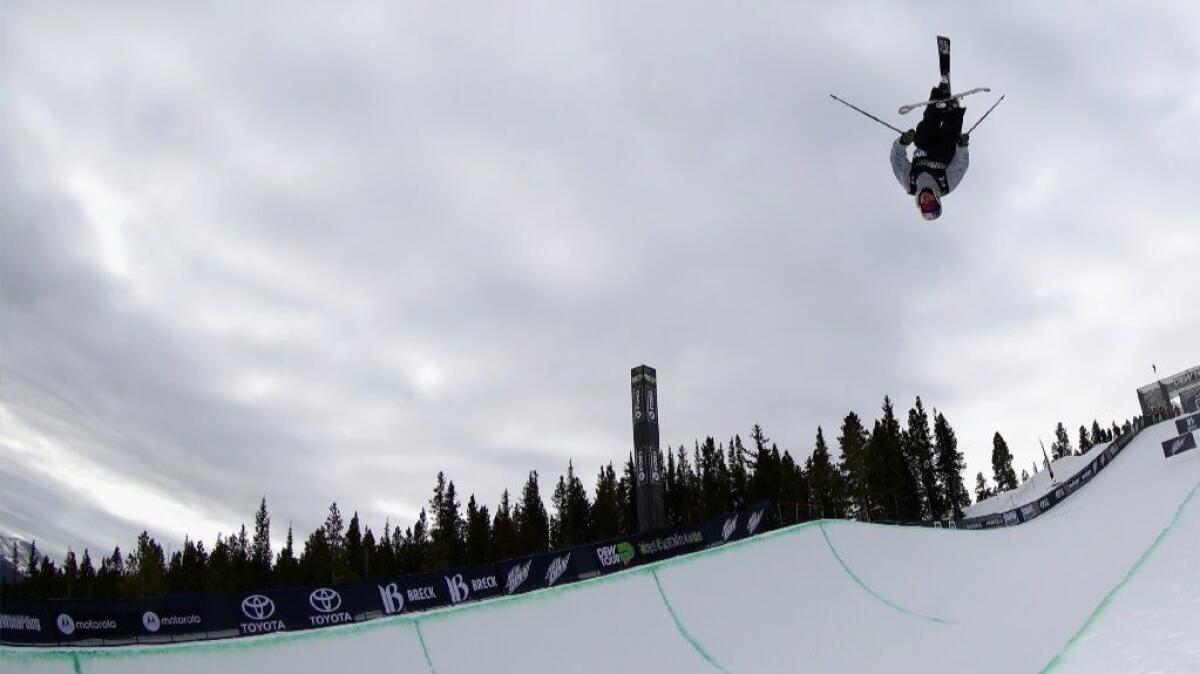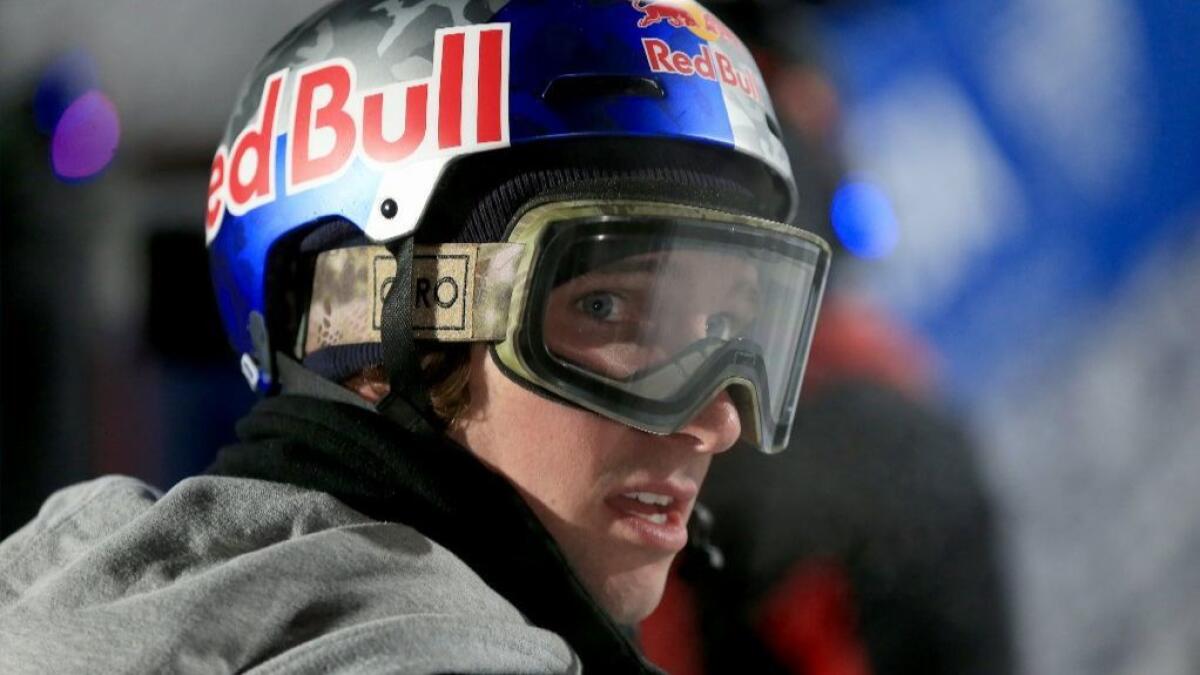Injuries cost two U.S. skiers their first shot at Olympic glory but led them to each other

- Share via
The darkest time? That would be the winter of 2015 and those dismal weeks spent lying around the living room of her family’s house.
Sarah Hendrickson took the couch, suffering with a knee injury that threatened to end her career as a world-class ski jumper.
Her boyfriend, freestyle skier Torin Yater-Wallace, slept on a twin bed they set up. Frail and exhausted, he was just out of the hospital where a septic infection had nearly killed him.
Television helped to pass the hours, but if you ask them now, they can’t really remember what they watched.
“Sometimes it felt like everything was raining down,” she says. “You just get through the days.”
A year earlier, Hendrickson and Yater-Wallace had been darlings of the U.S. Olympic team, young athletes expected to reach the podium at the 2014 Sochi Games in Russia with performances that would vault them to stardom.
“Things didn’t go as well as they were hyped-up to be,” Yater-Wallace says. “You question why things happen.”
Bad luck brought them together; it was something they had in common, something no one else could fully understand.
But this unfortunate bond also helped save them as they nursed each other back to health and back to the mountain. Now they arrive at the 2018 Winter Olympics with an altered outlook.
This isn’t a story about glory or gold medals or big endorsement dollars. It’s about perseverance.
“We kind of believe the hardest battles are for the strongest people,” Hendrickson says. “You put your head down and you keep going.”
Recovery is not only physical, but social and emotional as well. There’s doubt — am I going to be the same athlete I was before?
— Alex Cohen, a U.S. Olympic Committee psychologist
At the Summer Olympics, sprinters might tear a hamstring and basketball players occasionally twist their ankles. The Winter Games are different.
Downhill skiers and bobsledders risk their lives hurtling down the course. Snowboarders and ski jumpers launch themselves far above the cold, hard ground.
Serious injuries are common. So are tales of arduous rehabilitation.
“Recovery is not only physical, but social and emotional as well,” says Alex Cohen, a U.S. Olympic Committee psychologist. “There’s doubt — am I going to be the same athlete I was before?”
Before the 2014 Winter Games, Hendrickson was the biggest name in her nascent sport, having burst onto the scene as a teenager with a world championship and a World Cup season title.
Her talent was matched by a bright smile. Great things were expected of the Utah native.
Then came a training crash and torn knee ligaments. She limped onto the hill in Sochi and, had the honor of being the first woman jumper in an Olympic sport that previously had been limited to men.
It was a historic moment, but, Hendrickson says, “with my injury, it was really frustrating.”

Yater-Wallace, who comes from a renowned surfing family in Southern California but grew up in Aspen, Colo., had a similar story.
Freestyle halfpipe is much like its counterpart in snowboarding, except it’s done on skis. Competitors twist and turn through a series of tricks, and are judged by complexity and amplitude.
Winning a string of X Games medals as a teen, Yater-Wallace was on course for stardom, his slightly unruly hair and laid-back demeanor a perfect fit for a young sport.
But just like Hendrickson, he was injured shortly before the Olympics, suffering a collapsed lung and then broken ribs. Sochi was a letdown as he failed to make the final.
If you’re pissed off the whole time, it’s not going to make anything better. I learned to have optimism.
— U.S. freestyle skier Torin Yater-Wallace
Afterward, he and Hendrickson commiserated over pizza — their first date.
“Everybody thought both of us would win,” he says.
Back home, the troubles continued. Hendrickson re-injured her knee and, in the winter of 2015, Yater-Wallace began feeling abdominal pain. The discomfort landed him in a hospital, where tests revealed that a form of Streptococcus had infected his gallbladder and caused an abscess on his liver.
His health quickly deteriorated, prompting doctors to place him in a medically induced coma for more than a week. Hendrickson stayed at his bedside in intensive care, sleeping in the room some nights.
At one point, a nurse suggested they keep immediate family on call.
“Watching him in a hospital bed almost die for eight days is pretty much the worst thing you can imagine,” she says.
When his condition finally stabilized, she checked herself in for knee surgery.

Yater-Wallace considers himself a glass-half-full type of guy. This trait has unexpected origins.
His father, Ronald Wallace, pleaded guilty to fraud related to the sales of exclusive wines. His mother, Stace, battled cancer.
“If you’re pissed off the whole time, it’s not going to make anything better,” he says. “I learned to have optimism.”
His time in the ICU? The multiple surgeries Hendrickson endured? He looks on the bright side, insisting that adversity “kind of brought us together. It was our way to relate.”
Hendrickson isn’t quite as sanguine, saying: “I’m the negative one in the relationship.”
Moving into her parents’ home in Utah, turning the living room into a rehab ward, they needed each other.
It might not have mattered that he remained doggedly upbeat while she occasionally moped. When you listen to them reminisce about that time, something becomes clear.
He worried about her. She worried about him. It helped each of them to look past their own struggles.
Regardless of what happens at the Olympics, we’re proud of the journey we’ve had and what we’ve come back from.
— U.S. ski jumper Sarah Hendrickson
“Just having somebody there,” he says. “It’s better than sitting around lonely, not knowing when it will be over and when you’re going to catch a break.”
They watched television and, as their strength improved, took walks together. Eventually, they went to the gym.
Yater-Wallace progressed faster and began feeling an urge to ski, but still had drainage tubes inserted in his abdomen. Doctors warned that removing them too soon would increase the chances of re-infection.
That wasn’t about to stop Yater-Wallace. Not even close.
Three months after leaving the hospital, he took fifth at the 2016 X Games in Aspen. When asked about his hasty return, Hendrickson hesitates.
“It was his decision and he’s old enough to make that decision,” she says after a moment, adding: “That’s how we work together. We support each other.”

The past month has been a good one.
A third-place finish at the Toyota U.S. Grand Prix in mid-January secured Yater-Wallace’s spot on the American team. The next week, the 22-year-old took bronze at the X Games.
Solid results make him a favorite to reach the podium in Pyeongchang. They allow him to look back and call the past four years “an amazing ride.”
Hendrickson qualified by winning the U.S. team trials, where she landed a big jump and thrust her fists into the air as she reached the bottom of the hill.
Her prospects in South Korea are not as bright; three years and a total of four knee surgeries have passed since the 23-year-old finished among the top three in an international competition.
Still, she seems at peace.
“Of course I train every day because I want to win a medal,” she says. “But I don’t want to set my goals so that I walk away disappointed.”
This perspective reflects a change, something she and Yater-Wallace have adopted. It has little to do with the gold-or-bust approach that many elite athletes take.
“Regardless of what happens at the Olympics, we’re proud of the journey we’ve had and what we’ve come back from,” she says.
This time around, they just want to be healthy. They want a chance to give their best.
It is a mind-set forged from hardship. As Yater-Wallace says: “Life kind of teaches you lessons.”
Follow @LAtimesWharton on Twitter
Go beyond the scoreboard
Get the latest on L.A.'s teams in the daily Sports Report newsletter.
You may occasionally receive promotional content from the Los Angeles Times.




